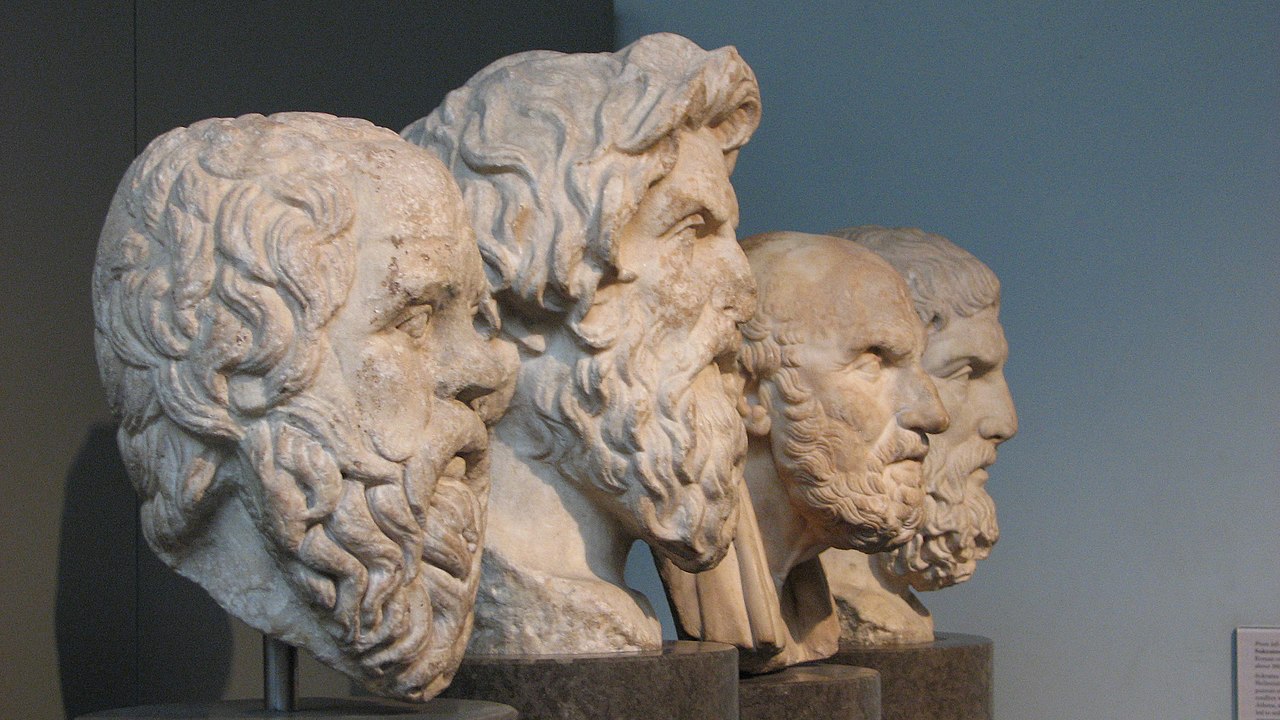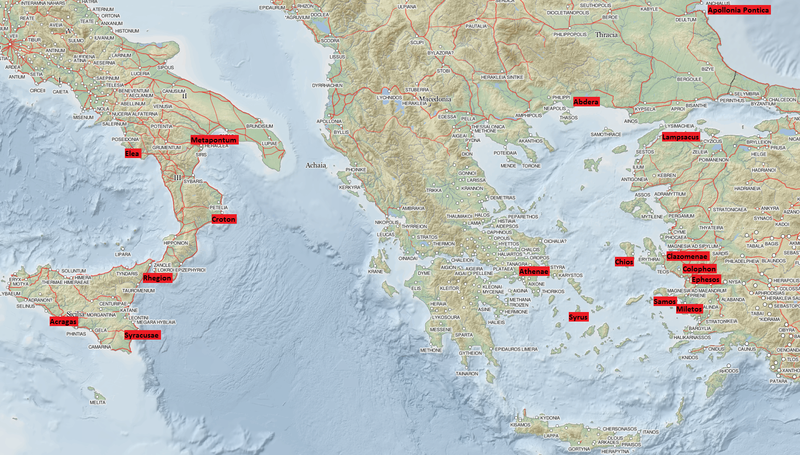5.1 The Metaphysics of The Pre-Socratics
LEARNING OBJECTIVES
By the end of this section you will discover:
- How the Greek philosophers before Socrates developed theories about the reality of the world around them based upon one or more of the classical “elements” found in nature: water, air, fire, etc.
Greek philosophy prior to Socrates seems to have been predominantly interested in Metaphysics, or questions and theories about the nature of reality. Their stories and ideas come to us largely in fragments from post-Socrates authors.

The pre-Socratic philosophers rejected traditional mythological explanations of the phenomena they saw around them in favor of more rational explanations. Aristotle was the first to call them physiologoi or physikoi (“physicists”, after physis, “nature“) and differentiate them from the earlier theologoi (theologians), or mythologoi (storytellers and bards) who attributed these phenomena to various gods.
The ancient historian Diogenes Laërtius divided the physiologoi into two groups: Ionian, led by Anaximander, and Italiote, led by Pythagoras. These philosophers asked questions about “the essence of things”:
- From where does everything come?
- From what is everything created?
- How do we explain the plurality of things found in nature?
- How might we describe nature mathematically?
Others concentrated on defining problems and paradoxes that became the basis for later mathematical, scientific, and philosophical study.
Later philosophers rejected many of the answers the early Greek philosophers provided but continued to place importance on their questions.

The Milesian School
The first pre-Socratic philosophers were from Miletus on the western coast of Anatolia. Thales (624-546 BC) is reputedly the father of Greek philosophy; he declared water to be the basis of all things. Next came Anaximander (610-546 BC), the first to write philosophy. He assumed as the first principle an undefined, unlimited substance without qualities (apeiron), out of which the primary opposites, hot and cold, moist and dry, became differentiated. His younger contemporary, Anaximenes (585-525 BC), took for his principle air, conceiving it as modified, by thickening and thinning, into fire, wind, clouds, water, and earth.
Pythagoreanism
The practical side of philosophy was introduced by Pythagoras (582-496 BC). Regarding the world as perfect harmony, dependent on number, he aimed at inducing humankind likewise to lead a harmonious life. His doctrine was adopted and extended by a large following of Pythagoreans who gathered at his school in south Italy in the town of Croton. His followers included Philolaus (470-380 BC), Alcmaeon of Croton, and Archytas (428-347 BC).
The Ephesian school
The Ephesian philosophers were interested in the natural world and the properties by which it is ordered. Xenophanes and Heraclitus were able to push philosophical inquiry further than the Milesian school by examining the nature of philosophical inquiry itself. In addition, they were also invested in furthering observations and explanations regarding the natural and physical processes and also the functions and processes of the human subjective experience.
Heraclitus and Xenophanes both shared interests in analyzing philosophical inquiry as they contemplated morality and religious belief. This was because they wanted to figure out the proper methods of understanding human knowledge and the ways humans fit into the world. This was much different from the natural philosophy that was being done by other philosophers, as it questioned how the universe operates as well as the place of humanity in the universe.
Heraclitus posited that all things in nature are in a state of perpetual flux, connected by logical structure or pattern, which he termed Logos. To Heraclitus, fire, one of the four classical elements, motivates and substantiates this eternal pattern. From fire, all things originate and return to it again in a process of eternal cycles.
The Eleatic school
The Eleatics emphasized the doctrine of the One. Xenophanes (570-470 BC) declared God to be the eternal unity permeating the universe and governing it by his thought. Parmenides (510-440 BC) affirmed the one unchanging existence to be alone true and capable of being conceived, and multitude and change to be an appearance without reality. This doctrine was defended by his younger countryman Zeno of Elea (490-430 BC) in a polemic against the common opinion which sees in things multitude, becoming, and change. Zeno propounded a number of celebrated paradoxes, much debated by later philosophers, which tried to show that proposing change or multiplicity leads to contradictions. Melissus of Samos (born c. 470 BC) was another eminent member of this school.
The Pluralist School
Empedocles appears to have partly agreed with the Eleatic School, and partly in opposition to it. On the one hand, he maintained the unchangeable nature of substance; on the other, he supposes a plurality of such substances – i.e., four classical elements, earth, water, air, and fire. Of these, the world is built up, by the agency of two ideal motive forces – love as the cause of union, and strife as the cause of separation. Anaxagoras (500-428 BC) in Asia Minor also maintained the existence of an ordering principle as well as a material substance, and while regarding the latter as an infinite multitude of imperishable primary elements, he conceived divine reason or Mind (nous) as ordering them. He explained all generation and disappearance as mixture and resolution respectively. To him belongs the credit for first establishing philosophy in Athens.
The Atomist School
The first explicitly materialistic system was formed by Leucippus (5th century BC) and his pupil Democritus (460-370 BC) from Thrace. This was the doctrine of atoms – small primary bodies infinite in number, indivisible and imperishable, qualitatively similar, but distinguished by their shapes. Moving eternally through the infinite void, they collide and unite, thus generating objects which differ in accordance with the varieties, in number, size, shape, and arrangement, of the atoms which compose them.
From the Pre-Socratics to the Present Day
These were some of the most important metaphysical concerns of some of the most esteemed ancient philosophers of the ancient world. As you can see, they encompass a wide range of topics and methods. In the rest of this chapter, we will introduce many of the metaphysical concepts, theories, and distinctions that have occupied philosophers in the many generations since, including the philosophers of today.
Works Cited
Bortes, Cristian. “British Museum – Four Greek Philosophers.” Wikimedia Commons, British Museum, 7 Sept. 2008, https://commons.wikimedia.org/wiki/File:British_Museum_-_Four_Greek_philosophers.jpg. Accessed 12 Apr. 2022.
Vermaas, Kiro. “Map of the Presocratic Greek World.” Wikimedia Commons, Wikimedia Commons, 24 Feb. 2017, https://commons.wikimedia.org/wiki/File:Map_of_the_Presocratic_Greek_World.png. Accessed 12 Apr. 2022.

